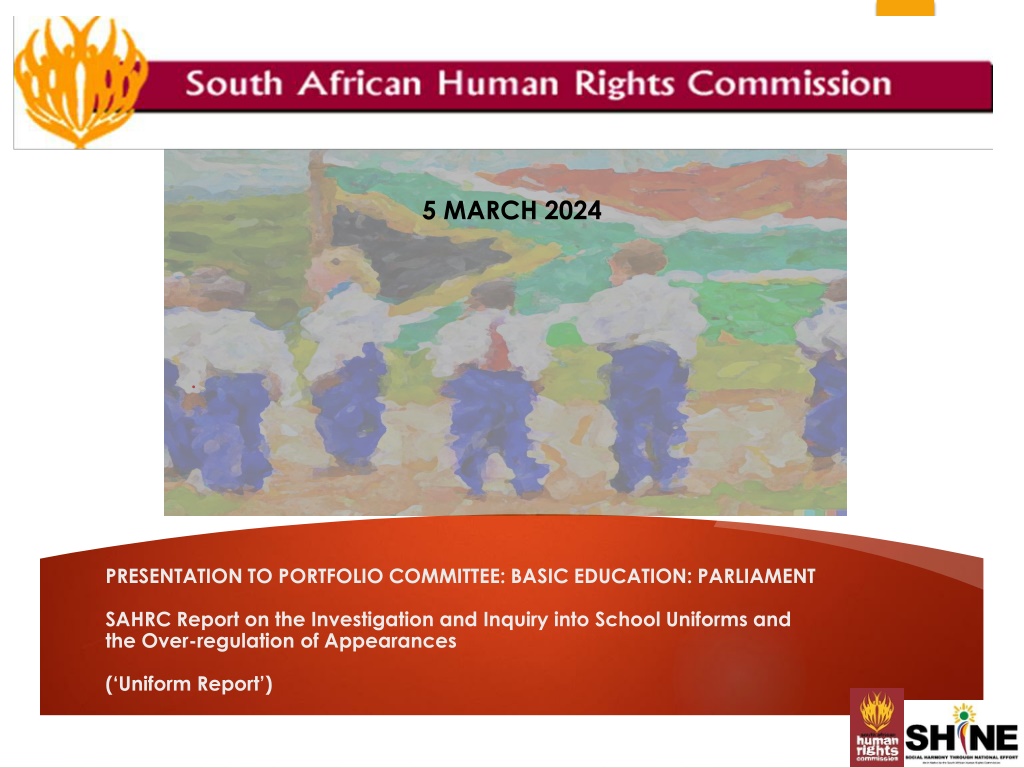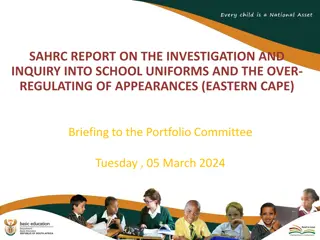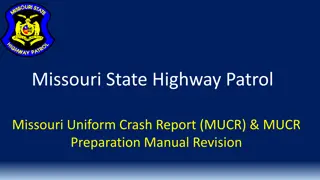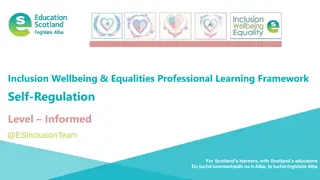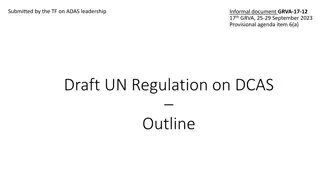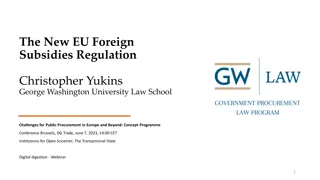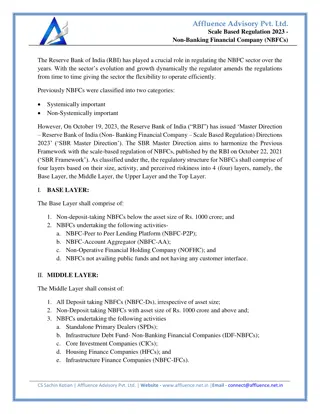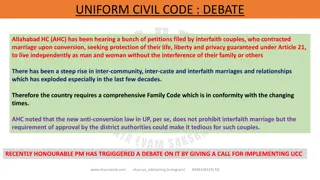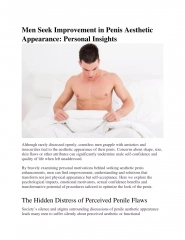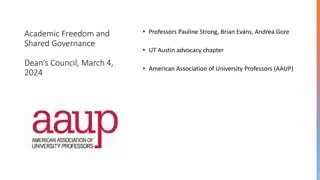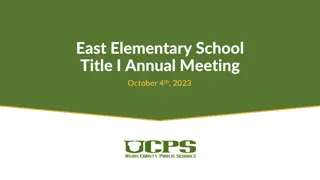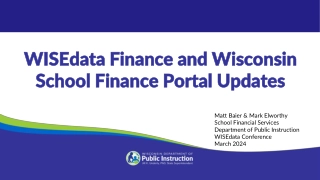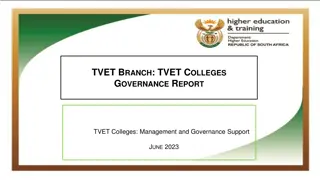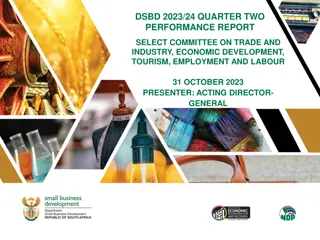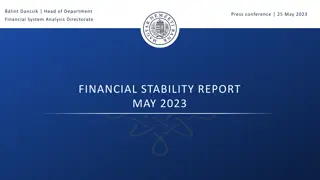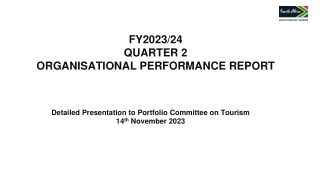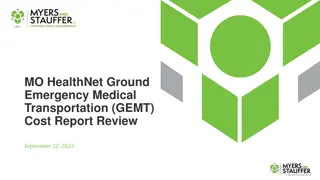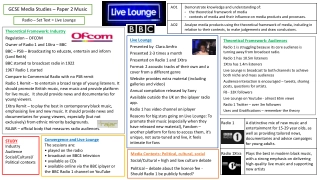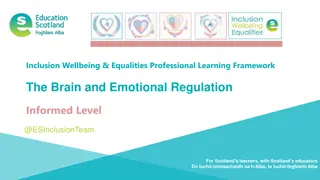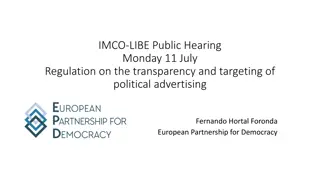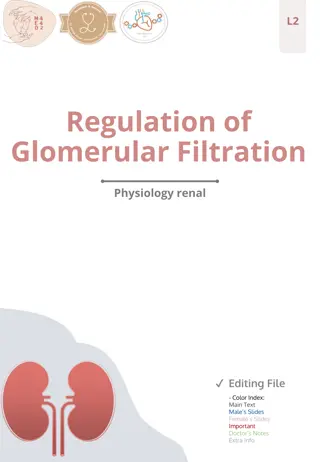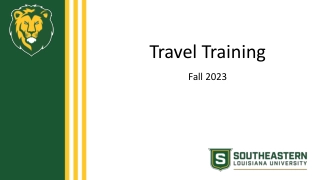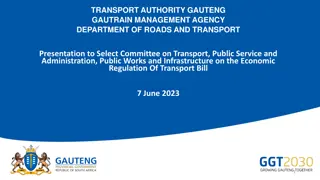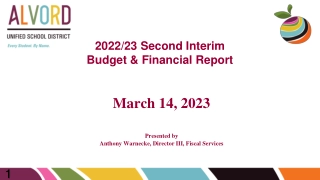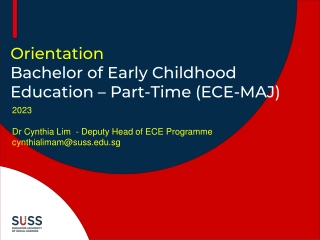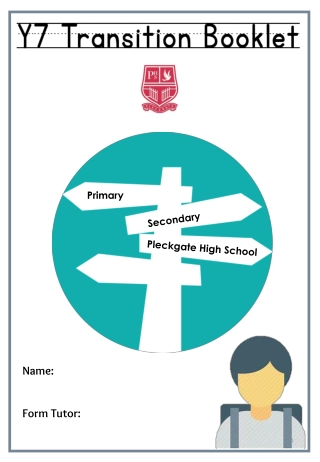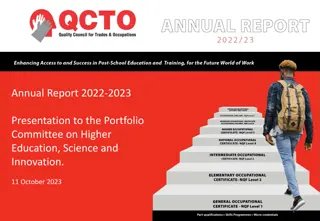SAHRC Report: School Uniform and Appearance Regulation Inquiry
The South African Human Rights Commission conducted an investigation and inquiry into school uniforms and over-regulation of appearances, addressing discrimination against learners. The Commission's mandate focuses on promoting and protecting human rights, with recommendations aimed at fostering respect and observance of human rights in educational settings.
SAHRC Report: School Uniform and Appearance Regulation Inquiry
PowerPoint presentation about 'SAHRC Report: School Uniform and Appearance Regulation Inquiry'. This presentation describes the topic on The South African Human Rights Commission conducted an investigation and inquiry into school uniforms and over-regulation of appearances, addressing discrimination against learners. The Commission's mandate focuses on promoting and protecting human rights, with recommendations aimed at fostering respect and observance of human rights in educational settings.. Download this presentation absolutely free.
Presentation Transcript
5 MARCH 2024 PRESENTATION TO PORTFOLIO COMMITTEE: BASIC EDUCATION: PARLIAMENT SAHRC Report on the Investigation and Inquiry into School Uniforms and the Over-regulation of Appearances ( Uniform Report )
2 Table of contents Mandate of the Commission Background & context Introduction Analysis Findings Recommendations
The South African Human Rights Commission (the Commission ) is an independent State institution established in terms of Section 181 of the Constitution of the Republic of South Africa Act, 108 of 1996 (the Constitution ) to strengthen constitutional democracy 3 The mandate of the Commission is derived from section 184 (1) of the Constitution in Commission is required to promote respect for human rights; promote the protection, development and attainment of human rights; and monitor and observance of human rights Introduction which the assess the
The Commission to perform its functions are derived from section 184 (2) of the Constitution which include: powers necessary for the 4 to investigate and to report on the observance of human rights to take steps to secure appropriate redress where human rights have been violated to carry out research to educate Mandate of the The powers including the South African Human Rights Commission Act 40 of 2013 ( SAHRCAct ). Section 13 of the SAHRC Act lists a number of powers and functions of the Commission, which includes investigate, on its own initiative or on receipt of a complaint, any alleged violation of human rights Commission in has of additional legislation, Commission terms the power to
5 Background & Context After noting an increase in reports of alleged overregulation of the school uniform and appearances of learners, the Commission, through its Eastern Cape Provincial Office resolved to not only further investigate these matters, but also to host an Inquiry into allegations of discrimination against learners in this regard. The Inquiry occurred in March 2022 and was hosted in Gqeberha, EC. The Inquiry further included the participation of numerous stakeholders, including the Eastern Cape Department of Basic Education (ECDBE), the Office of the Premier, associations representing independent and private schools, labour unions, tertiary institutions, parents, and non- governmental organizations
Analysis Summary of submissions Common themes emerged from submissions, revealing key aspects of the perceived role of school uniforms and associated challenges. Participants consistently recognized school uniforms for enhancing safety, discipline, and a conducive learning environment. Concerns arose regarding gender-neutral policies, regulation of hairstyles (particularly for black students), and the accommodation of cultural symbols. The notion of "excessive control and restrictions" and varying interpretations of national guidelines were recurrent issues, leading to inconsistent implementations. Discriminatory practices against gender non-conforming learners were identified, contravening constitutional protections. 6
The complexity of diversity and inclusion in South African schools, emphasizing the need for balanced policies respecting cultural and religious rights. Stakeholders stressed aligning school policies with constitutional principles, parental involvement in governance, and adapting policies to societal changes. Mediating cultural promoting adaptability, continuous reflection were recognized as crucial elements. Comprehensive guidelines addressing evolving perspectives at provincial and national levels were deemed essential. In summary, collectively advocated for policies fostering diversity, constitutional values African schools, emphasizing the need for an inclusive, adaptable, and rights- respecting educational environment. submissions highlighted the Analysis Summary of submissions contradictions, and the submissions inclusion, within and South 7
Analysis Historical Context School uniforms, influenced by European origins, evolved to symbolize conformity and socio-economic status. Protests in the 1960s challenged compulsory policies, questioning parental rights and expressing concerns about conformity and financial burdens. In the United States and Argentina, uniforms were linked to disciplining bodies and debates on freedom of expression. In Africa, colonialism introduced uniforms to distinguish between elite and uneducated children. South Africa adopted an assimilation approach, inheriting a system incompatible with its diverse culture. The historical legacy lacks Afrocentric perspectives, explaining the absence of traditional symbols in uniforms today 8
Analysis Purpose: Discipline One of the purposes of school uniforms, as cited by participants, includes improving discipline and academic performance. However, research results on the claimed benefits of uniforms, such as enhanced discipline and positive school climate perceptions, are inconclusive. The empirical evidence supporting the idea that uniforms enhance student performance is scarce. The Commission emphasizes reservations about the direct correlation between school uniforms and improved discipline or academic performance, underscoring the need for further research on this subject 9
Analysis Purpose: Safety The assertion that school uniforms significantly contribute to learner safety is questioned by the Commission. While uniforms are claimed to aid in learner identification and reduce gang-related issues, the Commission emphasizes that other security measures and community-wide efforts are crucial. Concerns about gang-related violence, often cited to justify uniform policies, are questioned based on the infrequency of such incidents on a national scale. The Commission suggests a localized approach, considering that gang-related issues are concentrated in specific regions, particularly the Western Cape, and may not be prevalent in other provinces. The narrative borrowed from the United States is scrutinized for its applicability to the South African context 10
Analysis Hair and Appearance Policies The Inquiry revealed significant and contentious issues regarding the regulation of learners' hair. Extreme measures, such as the "two-finger" policy for African male learners, and disciplinary actions for certain hairstyles or braids, caused anxiety and stress. Complaints highlighted biases rooted in Eurocentric norms, neglecting African hairstyles, which were historically stigmatized during apartheid. The "pencil test" used during apartheid reinforced the idea of straight hair superiority. Policing African students' hair is questioned, emphasizing the need to critically examine such actions given the historical context. The Inquiry affirms the importance of prioritizing the well-being and protection of children within the school environment, as seen in the Head of Department v Welkom High School case. 11
Analysis Hair and Appearance Policies cont Additionally Learners violating uniform and appearance policies may face disciplinary actions per the school's code of conduct. Offenses are categorized based on severity, with Grade 1 offenses being minor and unacceptable hairstyles. Disciplinary procedures for Grade 1 offenses involve warnings and hearings, while Grade 2 offenses escalate to a tribunal hearing. Grade 2 offenses including Notably, learners may face disciplinary action for natural hair or hair length, particularly boys. The Commission asserts that natural hairstyles should never be deemed an "offense," aligning with legal precedent. The lack of sound research supporting hair regulation is questioned, with concerns raised about the subjective nature of "neatness" standards and gender-based distinctions in hair length policies. 12
Analysis Binary Nature of Uniforms Schools in South Africa maintain a strict binary approach to uniform policies, reinforcing gender stereotypes and misogyny. These policies often regulate femininity, girlhood, and sexuality, perpetuating patriarchal norms. Girls face detailed dress codes, including instructions on underwear, contributing to appearance policing. The binary approach excludes gender non-conforming learners, prompting concerns about discrimination against the LGBTIQ+ community. Despite acknowledging social and educational roles, uniform policies are divided binary and treated as disciplinary matters. The Constitutional Court deems policies discriminating against learners as unlawful, emphasizing the importance of protecting LGBTIQ+ rights. The Commission advocates for gender-neutral uniform policies, allowing learners to dress according to their gender identity and expression, urging schools to refrain from stricter enforcement against gender non-conforming students 13
Analysis Cultural and Religious Attire Stakeholders are aware of the Pillay judgment, emphasizing learners' rights to cultural and religious expression. The court ruled against Durban Girls' High School, stating that preventing a learner from wearing a nose stud infringed on her rights and stressed the need to celebrate diversity. The decision highlighted the importance of realistic codes and exceptions, promoting reasonable accommodation. While guidelines recommend considering religious and cultural diversity, the Commission is concerned about the application process, which may be subjective and burdensome. Encouraging a rights-based approach, the Commission urges schools to prioritize dignity and self-expression without solely relying on administrative approval for exemption applications related to culture and religion 14
Right to Human dignity: It was found that in certain circumstances, school uniform and appearance policies infringed on a learners' right to dignity 15 No legitimate purpose for regulating hair length, applying different standards to male and female learners, disallowing natural hair, enforcing gender-stereotypical uniforms, regulating the colour of girls' hair and underwear, and treating appearance and uniform violations as disciplinary issues Findings Cost of school uniforms can be prohibitive, leading to a lack of access to education for some learners. The regulation of girls' underwear invades girls' privacy and dignity, as there is no way to enforce it without grossly violating their rights. Notably, there are no references to policies or codes that prescribe boys' underwear
Right to Equality: 16 Enforcing binary school uniform policies can be seen as enforcing traditional gender roles and norms, as uniforms often have different dress codes for boys and girls, potentially violating section 9 of the Constitution and section 9 of the Equality Act The enforcement of gendered school uniforms constitutes unfair discrimination, as it impairs human dignity, perpetuates stereotypes, and restricts learners' rights to express their gender identity freely Findings Policing the length of male learners' hair while not applying the same approach to female learners constitutes an infringement on the rights of male learners to be treated equally. Enforcing school uniform and appearance policies based on historical practices of policing and regulating the bodies of African and women learners is unacceptable
Right to Freedom of Belief, Religion, and Opinion; Right to Culture and Language: 17 Commission finds that a lack of a clear accommodation processes may violate the rights to culture, religion, and expression of learners The default position of accommodation should not be Eurocentric but must embrace the richness of South African cultural and religious diversity Findings Right to Freedom of expression: The Commission finds that the socioeconomic climate in South Africa justifies the enforcement of an obligatory school uniform policy generally, as it helps reduce socio- economic disparities among students, levelling the playing field School uniforms must however be affordable, available, reasonable and practical to serve their purpose. Compelling learners to procure expensive or impractical items is unjustified
18 The Best Interests of the Child: The Commission finds that bodily autonomy infringements such as the two-finger test on the bodies of African or other learners, and monitoring the colour of girls' underwear, can never serve the best interests of the child. These practices are archaic and degrading, violating section 28 of the Constitution. All other violations found above by the Commission also constitute violations of section 28 of the Constitution, as it can never be in a child s best interests to unjustifiably limit any of their human rights Findings The findings of this report have broad implications for all school uniform and appearance policies, irrespective of whether they are implemented in the public or private school sector. Patterns of overregulation in respect of school uniforms and learners' appearances have been identified that may infringe upon their fundamental human rights, as protected by the Constitution
19 Recommendations Immediate Reforms: Differentiating Hair Policies: The NDBE must abolish any hair policies differentiating between male and female learners, eliminating discriminatory practices related to Afros, braids, or natural hairstyles chosen by specific learners Gender-Stereotypical Uniform Policies: All learners should be allowed to wear any item of clothing forming part of the approved school uniform, irrespective of sex or gender identity. Gender-neutral options must be provided for gender-nonconforming learners Prescribed Underwear for Female Learners: The practice of prescribing underwear for female learners must be eradicated and condemned. Reporting invasive monitoring to law enforcement agencies is encouraged.
20 Recommendations Within Six Months: Audit of Codes of Conduct: The NDBE/PDE s must conduct an audit of all school codes to ensure deviation and accommodation processes, allowing learners to express their culture, religion, and beliefs Baseline Assessment and Cap on Uniform Costs: The NDBE should conduct a baseline assessment to determine a cap on the costs of basic school uniforms, considering socio-economic circumstances. Binding directives may be issued, emphasizing that expensive items like blazers are not compulsory. Amend the Uniform Guidelines: The NDBE must amend the Uniform Guidelines to include the Uniform Report's findings, considering binding directives instead of guidelines to prevent non-compliance
21 Recommendations Within Eight Months: Reporting on Implementation: The NDBE and PDE s must provide a report on addressing the above directives and recommendations within eight months, with clear timeframes and action items Applicability and Collaboration: The Commission acknowledges the role of SGBs and private school authorities but emphasizes the ultimate responsibility of the NDBE and PDE s for compliance with human rights. Private schools are urged to align policies with recommendations, fostering collaboration for inclusive and rights-respecting uniform policies
22 In conclusion, this Uniform Report is of paramount importance as it uncovers systemic violations of fundamental human rights within South African educational institutions. The findings underscore the urgent need for reforms in school uniform and appearance policies, with the aim to eliminate discriminatory practices that impact learners' rights to education, equality, dignity, and freedom of expression Having issued same, the Commission subsequently dispatched the Uniform Report to various stakeholders including Eastern Cape Department of Basic Education (ECDBE), the Office of the Premier, associations representing independent and private schools, labour unions, tertiary institutions, parents, and non-governmental organisations Concluding remarks The Commission confirms that responses were received from its sister Chapter 9 institution, CGE, as well as tertiary institutions where they provided their approval of the Uniform Report ***Note*** Nothing yet from ECDBE. In terms of rec s their report is due in April 2024 as the Uniform Report likely sent to them in October 2023.
23 THANK YOU QUESTIONS AND COMMENTS
CONTACT DETAILS Website: www.sahrc.org.za @SAHRCOMMISSION SAHUMANRIGHTSCOMMISSION SAHC1
